Research News
-
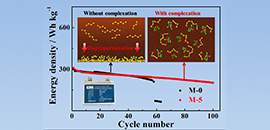 12 23, 2017New Lithium-Sulfur Battery Electrolyte: More Stable Capability and Longer Cycle LifeThe Energy Storage Technology Research Team headed by Professor ZHANG Huamin, Professor LI Xianfeng and Associate Professor ZHANG Hongzhang in Dalian Institute of Chemical Physics (DICP), Chinese Academy of Sciences (CAS) proposed a new lithium-sulfur (Li-S) battery electrolyte.
12 23, 2017New Lithium-Sulfur Battery Electrolyte: More Stable Capability and Longer Cycle LifeThe Energy Storage Technology Research Team headed by Professor ZHANG Huamin, Professor LI Xianfeng and Associate Professor ZHANG Hongzhang in Dalian Institute of Chemical Physics (DICP), Chinese Academy of Sciences (CAS) proposed a new lithium-sulfur (Li-S) battery electrolyte.
The Energy Storage Technology Research Team headed by Professor ZHANG Huamin, Professor LI Xianfeng and Associate Professor ZHANG Hongzhang in Dalian Institute of Chemical Physics (DICP), Chinese Academy of Sciences (CAS) proposed a new lithium-sulfur (Li-S) battery electrolyte.
They added a new kind of electrolyte additives, which include a large size cation, to complex and stabilize the polysulfide in the electrolyte. This new proposed electrolyte could achieve a high energy density Li-S battery with a longer cycle life. The related research has been published on Advanced Functional Materials.
The schematic principle of MEP +complexation in Li-S battery electrolyte. (Image by CHEN Yuqing)
Li-S batteries have been one of the hottest spots of international research in energy storage field, owing to their high energy density and low cost.
However, the practical application of Li-S batteries is still hindered by the rapid capacity of fading. It’s due to the shuttle effect and the disproportionation of polysulfide, and the decomposition of electrolyte and lithium dendrite.
In order to suppress the disproportionation of polysulfide, this research group introduced a kind of large size cation into the Li-S battery. This could complex and stabilize the soluble of polysulfide, which is based on the hard and soft acids and bases (HSAB) theory.
Such electrolyte enables a more stable capability and a longer cycle life: the 5000 mAh Li-S batteries (soft package type) can achieve an initial specific energy over 300 Wh/kg and can maintain almost 70 % after 100 charge/discharge cycles at 1/20 C.
This interesting finding is believed to shed a light on the further development of Li-S batteries.
The above research work was supported by DICP, National Natural Science Foundation of China, Youth Innovation Promotion Association of CAS, Dalian Science and Technology Star Program.
Dr. WANG Yongjin
Dalian Institute of Chemical Physics, Chinese Academy of Sciences,
457 Zhongshan Road, Dalian, 116023, China,
Tel: 86-411-84374221
E-mail: wangyj@dicp.ac.cn -
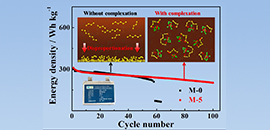 12 23, 2017New Lithium-Sulfur Battery Electrolyte: More Stable Capability and Longer Cycle LifeThe Energy Storage Technology Research Team headed by Professor ZHANG Huamin, Professor LI Xianfeng and Associate Professor ZHANG Hongzhang in Dalian Institute of Chemical Physics (DICP), Chinese Academy of Sciences (CAS) proposed a new lithium-sulfur (Li-S) battery electrolyte.
12 23, 2017New Lithium-Sulfur Battery Electrolyte: More Stable Capability and Longer Cycle LifeThe Energy Storage Technology Research Team headed by Professor ZHANG Huamin, Professor LI Xianfeng and Associate Professor ZHANG Hongzhang in Dalian Institute of Chemical Physics (DICP), Chinese Academy of Sciences (CAS) proposed a new lithium-sulfur (Li-S) battery electrolyte.
The Energy Storage Technology Research Team headed by Professor ZHANG Huamin, Professor LI Xianfeng and Associate Professor ZHANG Hongzhang in Dalian Institute of Chemical Physics (DICP), Chinese Academy of Sciences (CAS) proposed a new lithium-sulfur (Li-S) battery electrolyte.
They added a new kind of electrolyte additives, which include a large size cation, to complex and stabilize the polysulfide in the electrolyte. This new proposed electrolyte could achieve a high energy density Li-S battery with a longer cycle life. The related research has been published on Advanced Functional Materials.
The schematic principle of MEP +complexation in Li-S battery electrolyte. (Image by CHEN Yuqing)
Li-S batteries have been one of the hottest spots of international research in energy storage field, owing to their high energy density and low cost.
However, the practical application of Li-S batteries is still hindered by the rapid capacity of fading. It’s due to the shuttle effect and the disproportionation of polysulfide, and the decomposition of electrolyte and lithium dendrite.
In order to suppress the disproportionation of polysulfide, this research group introduced a kind of large size cation into the Li-S battery. This could complex and stabilize the soluble of polysulfide, which is based on the hard and soft acids and bases (HSAB) theory.
Such electrolyte enables a more stable capability and a longer cycle life: the 5000 mAh Li-S batteries (soft package type) can achieve an initial specific energy over 300 Wh/kg and can maintain almost 70 % after 100 charge/discharge cycles at 1/20 C.
This interesting finding is believed to shed a light on the further development of Li-S batteries.
The above research work was supported by DICP, National Natural Science Foundation of China, Youth Innovation Promotion Association of CAS, Dalian Science and Technology Star Program.
Dr. WANG Yongjin
Dalian Institute of Chemical Physics, Chinese Academy of Sciences,
457 Zhongshan Road, Dalian, 116023, China,
Tel: 86-411-84374221
E-mail: wangyj@dicp.ac.cn -
 12 07, 2017ZHANG Huamin is Awarded 2017 China Electrochemical Contribution Award
12 07, 2017ZHANG Huamin is Awarded 2017 China Electrochemical Contribution Award
On December 2nd to 4th, the 19th National Conference on Electrochemistry & ECS-CSE Joint Symposium on Electrochemistry of Energy & Environment was held in Shanghai.
Dr. ZHANG Huamin, the Professor of Dalian Institute of Chemical Physics (DICP), Chinese Academy of Sciences (CAS), was awarded 2017 China Electrochemical Contribution Award. In order to award his outstanding contribution to the research and the development of electrochemistry in energy storage technology.
ZHANG Huamin has been a famous expert in fuel cell and flow battery technology. He has been committed to the electrochemistry and technology of energy conversion and storage for long time. He has made great achievements in the fundamental and the industrial aspects of flow battery technology, which is from key materials preparation, battery stack design to system integration.
ZHANG Huamin has established a complete independent intellectual property system and industrial chain, and realized the industrialization transformation of the scientific research achievements successfully. He has pioneered the construction of the equipment production base with a capacity of 300MW/year and initiated a new industry of flow battery technology in China.
For his contributions to the advancement of flow battery technology, ZHANG Huamin was elected as the first "National Award for Innovation and excellence", the innovation talent promotion plan of "Talented people of scientific and technological innovation and enterprising" of Ministry of Science and Technology.
ZHANG Huamin has more than 380 publications, around 10000 citations, more than 180 granted patents and 2 books. He has presided the standardization work internationally and nationally for numerous years. Up to date, he has formulated 3 national standards, 7 industry standards in flow battery technology and 5 national standards in fuel cell technology.
The above achievements have been awarded the 2nd Prize for National Award for Technological Invention, Outstanding Scientific and Technological Achievement Award of the Chinese Academy of Sciences, Major Achievement Award of Liaoning Enterprise and First prize for Technical Inventions in Liaoning successively.
The China Electrochemical Contribution Award is awarded for distinguished work on the research and development of electrochemistry and technology over the past decade. The prize was funded in 2010 and conferred by the China Electrochemistry Commission. It opens every two years and goes to one or two scientists. (Text by ZHENG Qiong, Photo by WANG Guoxiong) -
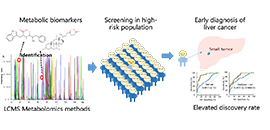 10 27, 2017Novel Biomarker Panel: Early Hepatocellular Carcinoma DiagnosisThe discovered and validated serum metabolite biomarker panel exhibits good diagnostic performance for the early detection of HCC from at-risk populations. This article is protected by copyright. All rights reserved.
10 27, 2017Novel Biomarker Panel: Early Hepatocellular Carcinoma DiagnosisThe discovered and validated serum metabolite biomarker panel exhibits good diagnostic performance for the early detection of HCC from at-risk populations. This article is protected by copyright. All rights reserved.
Hepatocellular carcinoma (HCC) is one of the most fatal malignancies with high death rate worldwide. And Hepatitis B virus (HBV) is the most relevant risk factor of HCC. China has a high incidence rate of HCC. It is one of the most important research goal for the National Key Project to lower the incidence and mortality of HCC.
However, HCC patients are commonly asymptomatic at the early stage, and the early metastasis leads to poor outcomes. Thus, new biomarkers for the screen of HCC are greatly needed.
The discovery and identification of metabolic biomarkers of hepatocellular (Image by YIN Peiyuan)
To address this challenge, Prof. XU Guowang et al. from Dalian Institute of Chemical Physics (DICP), Chinese Academy of Sciences identified a novel biomarker panel for the early diagnosis of hepatocellular carcinoma. This work has been published in Hepatology.
This group cooperated with 6 domestic hospitals to study 1448 individuals, including health controls, hepatitis, liver cirrhosis, HCC and intrahepatic cholangiocellular carcinoma, etc. By using home-developed pseudotargeted metabolomics method, a novel biomarker pattern consisting of phenylalanyl-tryptophan and glycocholate was found and identified.
The results showed that this panel had a higher diagnostic performance than α-fetoprotein (AFP), which is the traditional biomarker for HCC. Besides, this panel showed a better performance to distinguish small HCC: 80.6% of the AFP false-negative patients with HCC were correctly diagnosed using this panel in the test set. The specificity and biological relevance of the identified biomarkers were further evaluated using sera from other two cancers and HCC tissue specimens, respectively.
In the nested case-control study, this panel had high sensitivity (rang 80.0-70.3%) to detect preclinical HCC. And its combination with AFP provided better risk prediction of preclinical HCC before clinical diagnosis.
This study has been supported by the National Key Research and Development Program of China on Precision Medicine, the National Key Project of Science and Technology of China, the projects and key project from the National Natural Science Foundation of China.
Dr. WANG Yongjin
Dalian Institute of Chemical Physics, Chinese Academy of Sciences,
457 Zhongshan Road, Dalian, 116023, China,
Tel: 86-411-84374221
E-mail: wangyj@dicp.ac.cn -
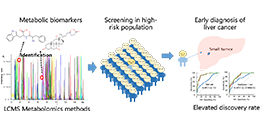 10 27, 2017Novel Biomarker Panel: Early Hepatocellular Carcinoma DiagnosisThe discovered and validated serum metabolite biomarker panel exhibits good diagnostic performance for the early detection of HCC from at-risk populations. This article is protected by copyright. All rights reserved.
10 27, 2017Novel Biomarker Panel: Early Hepatocellular Carcinoma DiagnosisThe discovered and validated serum metabolite biomarker panel exhibits good diagnostic performance for the early detection of HCC from at-risk populations. This article is protected by copyright. All rights reserved.
Hepatocellular carcinoma (HCC) is one of the most fatal malignancies with high death rate worldwide. And Hepatitis B virus (HBV) is the most relevant risk factor of HCC. China has a high incidence rate of HCC. It is one of the most important research goal for the National Key Project to lower the incidence and mortality of HCC.
However, HCC patients are commonly asymptomatic at the early stage, and the early metastasis leads to poor outcomes. Thus, new biomarkers for the screen of HCC are greatly needed.
The discovery and identification of metabolic biomarkers of hepatocellular (Image by YIN Peiyuan)
To address this challenge, Prof. XU Guowang et al. from Dalian Institute of Chemical Physics (DICP), Chinese Academy of Sciences identified a novel biomarker panel for the early diagnosis of hepatocellular carcinoma. This work has been published in Hepatology.
This group cooperated with 6 domestic hospitals to study 1448 individuals, including health controls, hepatitis, liver cirrhosis, HCC and intrahepatic cholangiocellular carcinoma, etc. By using home-developed pseudotargeted metabolomics method, a novel biomarker pattern consisting of phenylalanyl-tryptophan and glycocholate was found and identified.
The results showed that this panel had a higher diagnostic performance than α-fetoprotein (AFP), which is the traditional biomarker for HCC. Besides, this panel showed a better performance to distinguish small HCC: 80.6% of the AFP false-negative patients with HCC were correctly diagnosed using this panel in the test set. The specificity and biological relevance of the identified biomarkers were further evaluated using sera from other two cancers and HCC tissue specimens, respectively.
In the nested case-control study, this panel had high sensitivity (rang 80.0-70.3%) to detect preclinical HCC. And its combination with AFP provided better risk prediction of preclinical HCC before clinical diagnosis.
This study has been supported by the National Key Research and Development Program of China on Precision Medicine, the National Key Project of Science and Technology of China, the projects and key project from the National Natural Science Foundation of China.
Dr. WANG Yongjin
Dalian Institute of Chemical Physics, Chinese Academy of Sciences,
457 Zhongshan Road, Dalian, 116023, China,
Tel: 86-411-84374221
E-mail: wangyj@dicp.ac.cn -
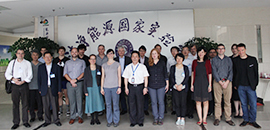 10 10, 2017The 7th Chemical Sciences and Society Summit is Held in Dalian
10 10, 2017The 7th Chemical Sciences and Society Summit is Held in Dalian
The 7th Chemical Sciences and Society Summit (CS3)was held in Dalian on September 6th to 8th, 2017, which was organized by the Chemical Society of China, the United States, Germany, Britain, Japan and National Natural Science Foundation of China. 2017 CS3 was focusing “Solar Energy & Photonics for a Sustainable Future”, and covering the four sub-topics: Artificial Photosynthesis and CO2 Reduction; New PV Materials with Abundant Elements; Photonic Materials and Photon Upconversion and Photofunctional Materials and Structures for Light Manipulation.
Prof. LI Can from the Dalian Institute of Chemical Physics, Chinese Academy of Sciences was the head of Chinese delegation and the scientific chair of this summit. During the three days meeting, 40 experts from China, Germany, Japan, the UK and the USA came together and discussed the issues of the sustainable future of solar energy and photonics. The results of the discussion will be condensed and summarized into a white paper.
On the 8th September, CS3 participants visited Dalian Institute of Chemical Physics, vice director Prof. JIN Yuqi met the visitors and gave the brief introduction of DICP. Then participants visited Energy Storage Division, Fuel Cell & Battery Division, Solar Energy Division and Nano and Interfacial Catalysis Group.
The CS3 initiative is a collaboration between the Chinese Chemical Society (CCS), the German Chemical Society (GDCh), the Chemical Society of Japan (CSJ), the Royal Society of Chemistry (RSC), and the American Chemical Society (ACS). The symposia series is supported by the National Science Foundation of China (NSFC), the German Research Foundation (DFG), the Japan Science and Technology Agency (JST), the UK Engineering and Physical Sciences Research Council (EPSRC), and the U.S. National Science Foundation (NSF). CS3 brings together some of the best minds in chemical research from around the world and challenges them to propose innovative solutions to society’s most pressing needs in health, food, energy, and the environment. This unique gathering boasts an innovative format, aiming to set the course of international science, and rotates among participating nations.
China is the one of initiators of CS3, and is the only representative of the developing countries, which is the proof of the improvement of the international status of basic research in chemistry of China. Taking part in this summit can help China enhance the international status in chemistry; promotes China’s young chemical scientists to enter into the research frontier; reflects Chinese’s responsibility as the super country.
Solar energy research team, led by Prof. LI Can, focuses the research on solar energy photocatalysis, photocatalytic decomposition of hydrogen in water and reduction of carbon dioxide. Over the past decade, the research team has made significant progress in the field of cutting-edge scientific research: with the strategy of dual co-catalysts loaded on semiconductor, the photocatalytic hydrogen production quantum efficient can reach up to 93%, which is the highest record in the world; new conception of phase junction promoting charge separation and photocatalytic performance was proposed; new phenomenon of charge separation between the different facets of semiconductor crystal was found; with the new conception and strategy of fabrication“hole-storage layer”on the photoelectrochemical electrode for water splitting, theoretical photocurrent limit under sunlight was approached. Based on these advances on fundamental understandings, the solar to hydrogen (STH) efficiencies in many photocatalysis systems were significantly improved. To achieve a deep understanding on the fundamentals in this field, home-made scanning photoelectric imaging method was developed and provided new opportunities to directly visualize photogenerated charge separation and understand the driving force in photocatalyst on nano/micro meter scale.
These basic scientific work has promoted the research level of solar energy photocatalysis and photoelectric catalysis in DICP and even in China, and has an important influence in the field of solar energy artificial light synthesis around the world. (Text and Photo by LIU Jiajia)